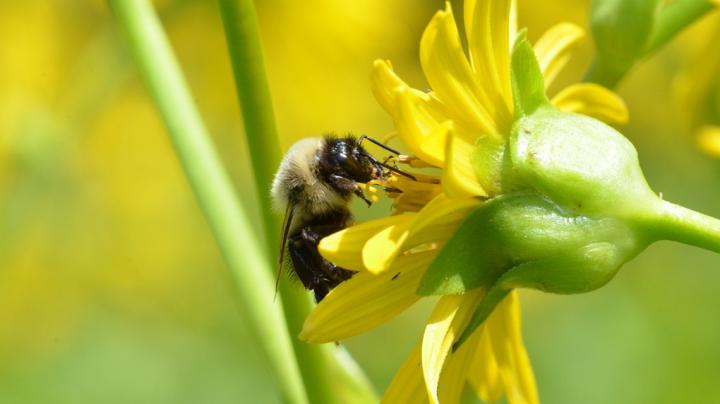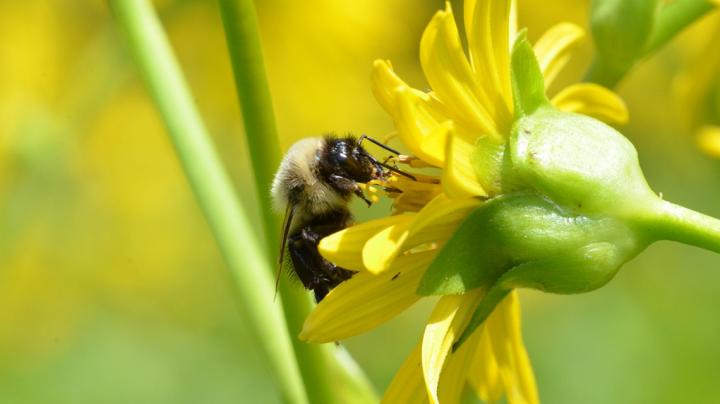
Credit: Heather Grab
ITHACA, N.Y. – With bee pollinators in decline and pesky crop pests lowering yields, sustainable and organic farmers need environmentally friendly solutions.
One strategy is to border crops with wildflower plantings to attract pollinators and pest predators. But scientists have suggested that such plantings may only be effective when farms are surrounded by the right mix of natural habitat and agricultural land.
For the first time, a Cornell University study of strawberry crops on New York farms tested this theory and found that wildflower strips on farms added pollinators when the farm lay within a "Goldilocks zone," where 25 to 55 percent of the surrounding area contained natural lands. Outside this zone, flower plantings also drew more strawberry pests, while having no effect on wasps that kill those pests.
Still, more pollinators in this ideal landscape zone boosted strawberry yields overall. The analysis has implications for many types of state and federal programs in the United States and abroad that promote establishing pollinator habitats on farms.
"We're investing huge amounts of money on these programs and right now it's not part of the policy to think about the landscape context of where these habitats are placed," said Heather Grab, Ph.D. '17, the paper's first author and a postdoctoral researcher in the lab of Katja Poveda, associate professor of entomology and a co-author of the study.
The paper, "Landscape Context Shifts the Balance of Costs and Benefits From Wildflower Border on Multiple Ecosystem Services," published Aug. 1 in Proceedings of the Royal Society B, suggests targeting wildflower borders to farms with the right conditions and modifying wildflower plant species could maximize success.
The rationale behind the Goldilocks zone theory: wildflower strips surrounded by too much natural land would not add additional beneficial insects, because ample habitat would drown out a small strip of flowers. On the other hand, farms surrounded by other farms are already low on natural habitat and beneficial insects, making a wildflower strip too small to attract more insects.
"It's in this zone in the middle, where there's enough natural habitat around, and there are beneficial insects there, and you can attract them [insects] from the natural habitat into the crop habitat to actually see a benefit in terms of crop production," Grab said.
In the study, the researchers planted strawberry plots on 12 small New York state farms that represented a gradient of landscapes, from farms surrounded by natural habitat to farms next to agricultural lands. Each farm had two strawberry plantings, one plot bordered by a wildflower strip, and another control plot on the other side of the farm, edged with mowed grass.
The researchers conducted surveys of pollinators, pests, wasps that parasitize pests, fruit yield and fruit damage over three years. The tiny parasitizing wasps lay their eggs inside tarnished plant bug nymphs – a pest that costs New York strawberry growers 30 percent of their annual yield. When the eggs hatch, the larvae feed on the nymphs.
The wildflower strips were increasingly effective at attracting pollinators as each year passed. The result that "between 25 and 55 percent [surrounding natural landscapes] was the best range in terms of promoting bees," closely matched what the Goldilocks theory predicted, Grab said.
But when it came to pests, wildflowers outside the Goldilocks zone attracted the most pests and didn't add more wasps. "It suggests the parasitoids are not responding to wildflower strips at all," Grab said. More study is needed to understand why.
Analyses revealed many wildflower species attracted both pests and bees, but some species like fleabane (Erigeron annuus) lured the most pests and were least effective at drawing bees.
"If you wanted to optimize the wildflower patches, I would suggest we eliminate some of those from the list of recommended species in the plantings," Grab said.
Future work will investigate how floral habitats influence pathogen transmission for bees, the leading driver of bee declines.
Bryan Danforth and Greg Loeb, Cornell professors of entomology, co-authored the study, which was funded in part by a Northeast Sustainable Agriculture Research and Education grant.
Cornell University has dedicated television and audio studios available for media interviews supporting full HD, ISDN and web-based platforms. For additional information, see this Cornell Chronicle story.
-30-
###
Media Contact
Lindsey Hadlock
[email protected]
607-269-6911
@cornell
http://pressoffice.cornell.edu
Original Source
http://news.cornell.edu/stories/2018/09/study-reveals-best-use-wildflowers-benefit-crops-farms http://dx.doi.org/10.1098/rspb.2018.1102





